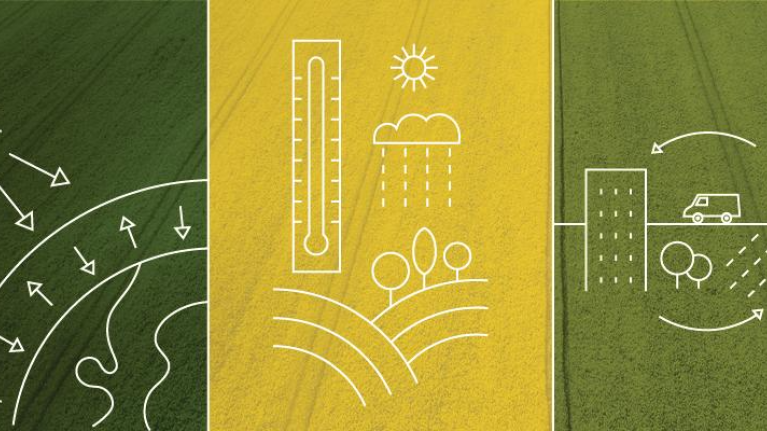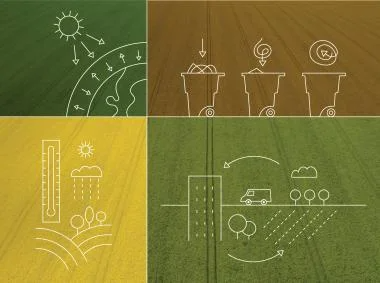
The Language of Climate Change: A Glossary of Terms
Everybody’s talking about climate change, environment and sustainability. And if you want to join the conversation, it’s important that you know and understand the vocabulary too.
Being familiar with these terms can help you make better decisions when it comes to running your company. It will also give you the knowledge you need to share what you learn and answer questions from your staff and customers.
GREENHOUSE GASES (GHGs)
Greenhouse gases are substances in the atmosphere that trap heat close to Earth’s surface, causing the greenhouse effect. The primary GHGs are water vapor, carbon dioxide, nitrous oxide, methane, and ozone1.
CARBON DIOXIDE
This gas occurs naturally and as a by-product of burning fossil fuels and biomass, land use, and other industrial processes1. It is the main human-caused greenhouse gas2.
CLIMATE CHANGE
Any change in the climate that persists for an extended period. It can be caused by natural processes, forces like solar cycles or volcanic eruptions, or human activity that changes the composition of the atmosphere1.
GLOBAL WARMING
The estimated increase in global mean surface temperature averaged over a 30-year period, compared to pre-industrial levels1.
CARBON NEUTRAL
A product that has a carbon footprint of zero or that has been offset. To be carbon neutral, all GHG emissions from all stages of a product’s life cycle must be reduced, removed, or accounted for through a system of offsets or credits3.
NET ZERO EMISSIONS
Corporate targets that align with societal climate change goals by:
1. Reducing value chain emissions to meet guidelines for limiting global temperature increases to 1.5˚C, and
2. Neutralizing the impact of any residual emissions by permanently removing an equal amount of CO2 by volume4.
THE PARIS AGREEMENT
The Paris Agreement is an international treaty on climate change adopted by 196 parties
in 2015. Its goal is to limit global warming to 2º C (and preferably 1.5º C) compared to pre-industrial levels5.
LINEAR ECONOMY
This take-make-waste model uses natural resources to make products that are thrown away at the end of its life, wasting those materials instead of finding new uses for them6.
CIRCULAR ECONOMY
An economy that is regenerative by design and aims to gradually decouple growth from the consumption of finite resources. It's based on three principles: eliminate waste and pollution, circulate products and materials and regenerate nature6.
CARBON FOOTPRINT
The total amount of GHG emissions of both processes and products3 emitted by a person, family, building, organization, or company each year2.
LIFECYCLE ASSESSMENT (LCA)
Compilation and evaluation of the inputs, outputs and potential environmental impacts of a product, service or system throughout its life cycle, from raw materials extraction to end-of-life7.
REGENERATIVE AGRICULTURE
An approach to farming that aims to conserve and restore farmland and its ecosystem. It contributes to drawing down carbon dioxide from the atmosphere and reducing emissions of GHGs and it helps deliver benefits to farmers, environment and society8.
CARBON REDUCTION
Any practice that reduces carbon emissions.
CARBON REMOVAL (CARBON INSETTING)
This process absorbs CO2 from the atmosphere and stores it somewhere else, such as trees, soil, or underground storage all along the supply chain1.9.
CARBON CREDITS (CARBON OFFSETTING)
A mechanism to compensate for the carbon footprint of a product by preventing the release of, reducing, or removing an equivalent amount of GHG emissions in a process outside the boundary of the product throughout its life cycle3. Companies and individuals can balance unavoidable emissions by buying carbon credits from certified activities9.
Sources
1 The IPCC Glossary
2 United States Environmental Protection Agency (EPA), Glossary of Climate Change Terms
3 ISO 14021:2016, Environmental labels and declarations
4 Science Based Targets, The SBTi Net-Zero Manual & Criteria
5 United Nations, The Paris Agreement
6 Ellen Macarthur Foundation, What is a circular economy?
7 ISO 14040:2006, Environmental management
8 Nestlé, Regenerative Agriculture
9 Southpole, Insetting: the Full-circle Sustainable Solution for Supply Chains; Carbon Offsets Explained
